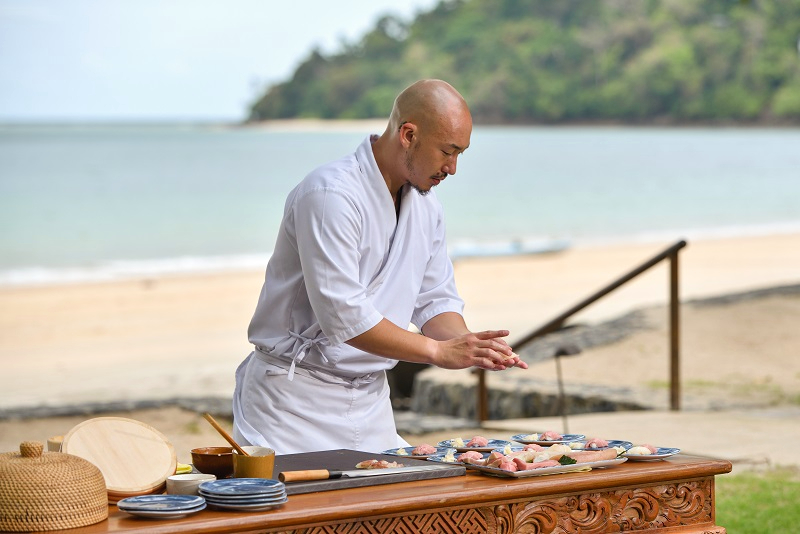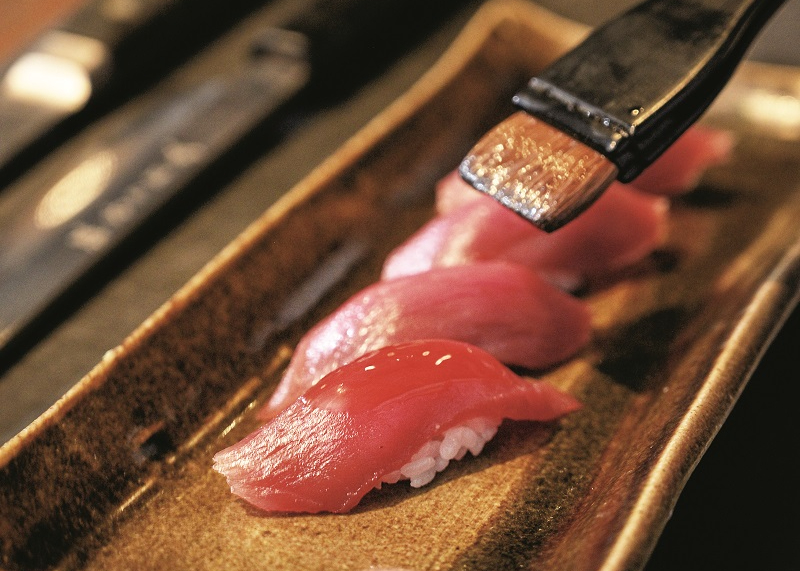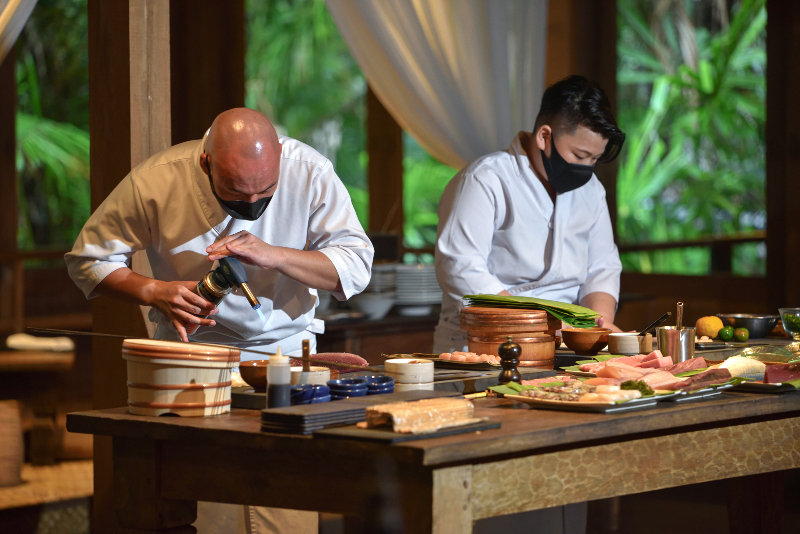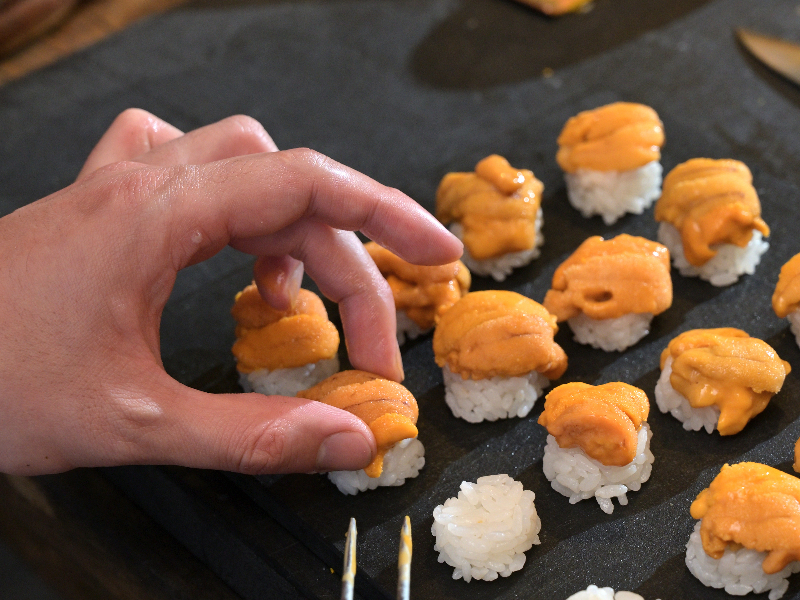
Tropical ceviche garnished with edible Mexican creepers (All photos: The Datai Langkawi)
Taste, so neurologically intertwined with memory, is an emotional catapult that can conjure up slivers of time, place and comfort. Yet, what laid disconcertingly atop our ceviche was an unfamiliar wreath — the droopy pink blossoms were so delicate, they fluttered at the whisper of a breeze — accentuating the highly familiar mix of scallop, squid and lime. Unlike the requisite garnish of shiso or myoga (ginger) flowerhead found in an omakase spread, resting on our chopsticks was a decorative bud that lacked the voluptuous aroma of a spicy kinome leaf but teased with enough peppery undertone to lift a cold appetiser.
Seized by curiosity, we sought the expertise of The Datai’s resident botanist, Izzati Noh, the next day, only to discover that these Mexican creepers called antigonon leptopus, or coral vine, are so common, they hang tantalisingly on a fence in the resort’s garden. A farm-to-table dish has the ability to incite a sense of adventure, since herbs and foraging are in the ascendant once more as edible gems travel from forest floors to porcelain plates. However, we need not venture far — our very backyard is where the wild things are.
The art of plating reflects an aspect of a chef’s craftsmanship as ingredients should never be deployed with abandon. Naturally, every cook has to think about that, be it at an austere sushi-ya, where the tab starts at three figures, or the humble mom-and-pop shokudo. But some, like chef Masaki Arakawa, who helmed the second edition of The Datai’s Chef Series, think about it more than others. Asked about the use of greenish umi budo (sea grapes) in his bara chirashi dish during the chef demonstration prior to the main event, he said, “It’s part of goshiki to make the bowl of ‘scattered’ chopped fish look more appetising.” He went on to explain how food is plated in consideration of the colours red, yellow, blue (or green), white and black to heighten visual appeal.
chef_masaki_arakawa-cooking_demo_at_the_beach_demo.jpg

Each tenet of Japanese cooking is governed by the five fives: goho (method); gokan (sense); gomi (taste); goshiki (colour); and gokan no mon (viewpoint). But even for the head chef of Sushi Azabu in Bukit Bintang’s Lot 10 — an outpost of the 1-Michelin starred New York mainstay that specialises in a 200-year-old sushi art form call edomae — the cardinal principles of freshness and aesthetic need not always align with reverence for customs.
“We can still be authentic, yet not too strict with traditions either, because customers’ palates are constantly evolving. We need to work around change, and innovate on it, so that tradition can be passed on and have a place in modern dining,” said Arakawa, 29, who worked at a Japanese fusion restaurant in Melbourne, Australia, and cut his teeth at Osaka’s Insyokujin Daigaku. He joined the F&B industry as a bartender when he was only 16, a job that led to his true calling of entertaining guests behind a counter, whether serving negronis or nigiris. “The skill that goes into crafting a cocktail is the same as perfecting a piece of sushi — all ingredients need to come cohesively as one.”
nigiri.jpg

The Chef Series dinner was testament to it all when he challenged long-held ideas of authenticity but still flaunted techniques that were forbiddingly precise through a nine-course omakase with saké pairing. Already a kicker was the sparkling Shichiken Yamanashi, whose merry effervescence cued a succession of Arakawa’s greatest hits that made Azabu’s name. Rice wines used to take their place by the whites but they have quietly ascended to the pedestal on which we have placed sublime vinos. Likened to a young Chardonnay, the Tanaka 1789 x Chartier with delicate fruitiness played up the texture of our plump Nagasaki oyster that wobbled between flesh and cream. Instead of a bubbling broth, the wagyu sukiyaki dipped in a shallow bath of konbu dashi, once stirred in with a raw egg, was an epiphany we would now forever associate with autumn and culinary ingenuity.
If Arakawa’s opening acts swam against the tide of tradition, the mains were steadfast proofs of the classic 19th-century sushi style he has refined. Edomae originated as street food in Tokyo, when lack of refrigeration required curing or marinating to preserve a fish’s texture. Thus, what landed on our plate ranged from tenggiri sashimi (as a nod to The Datai’s promise of including local bounty) marinated in soy sauce to grouper that had been pressed between sheets of kombu via the ancient kobujime curing method. On a wee cushion of rice shaped between agile fingers, every slab of fish glistening with just a swipe of semi-sweet glaze, particularly the maguro toro, was a love letter to the sea. The aforementioned bara chirashi also made a reappearance in its full iteration, this time as a hunk of mackerel tucked neatly between crisp, smoky nori.
chef_masaki_arakawa-dinner_at_the_gulai_house_4.jpg

In between the theatrics, Arakawa shuttled plates of pickled horseradish and cured tuna stomach from the sprawling table of seafood where he held court. “Eat them like cheese, just as how you would with wine,” he suggested, and nudged the saké in our direction. This was Arakawa’s nifty trick of drawing our attention away from the intensity of a single pleasure, before populating our palate again with unctuous flavours such as Hokkaido’s famed sea urchin, or uni. Sporting a bright tangerine hue, the prized roe — one sweeter, from Hamanaka, and the other, a mineral-tasting version from Kiritappu — seesawed between saline sharpness and buttery opulence.
During Arakawa’s session, all ingredients — be it the wasabi with a pungency that burrows in your nose or the yuzu and sweet turnip especially imported from Japan — were presented respectfully and sparsely within the narrow window of ripeness so one can sample their optimum flavours and the care that has gone into them. An omakase is a fastidious ritual, but rituals need not harden into rules. Sushi Azabu, like the contrasting country of Japan itself, illustrated that tradition can be served with a side of imagination, hot-cold chemistry and youthful enthusiasm. Although we wished we had dined with sand between our toes by the beach (the venue shifted indoors, no thanks to the relentless rain), the second Chef Series ended with guests rolling their heads back in surprise and satisfaction.
sea_urchin.jpg

The Datai Langkawi’s Chef Series 2022 is a six-part culinary adventure featuring some of Malaysia’s most prominent chefs. Look out for OpenHouse’s Chef Azli Ahmad in the third edition on April 22 and 23. Book here.
This article first appeared on Mar 14, 2022 in The Edge Malaysia.


